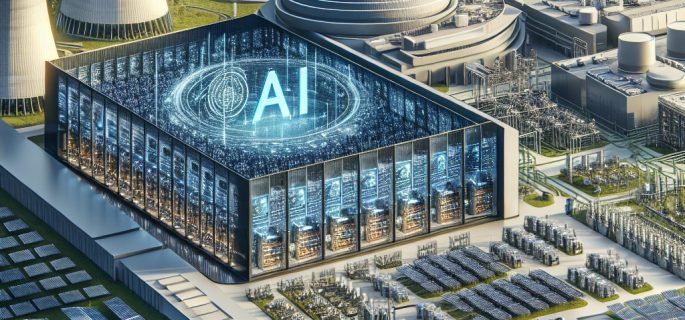AI’s Power Surge Calls for Nuclear, But It Won’t Be Enough: Goldman Sachs

Source: ShutterStock
With the rapid growth of artificial intelligence, the demand for power in data centers is skyrocketing. Nuclear energy is poised to play a crucial role in the evolving energy landscape. However, nuclear energy alone won’t solve the energy puzzle. Other energy sources, including natural gas, renewable energy, and advanced battery technology, will be needed to meet the energy needs, according to Goldman Sachs Research.
Reports by senior analysts at Goldman Sachs, including Brian Singer, Jim Schneider, and Carly Davenport, forecast that AI’s demand from data centers will increase 50% by 2027 and by as much as 160% by the end of the decade, based on 2023 figures.
The growing demand for data center power could require an estimated 85-90 gigawatts (GW) of new nuclear capacity by 2030 to keep up with projected growth. However, less than 10% will be available globally by 2030.
As energy demands rise, improvements in data center efficiency are starting to slow, according to Davenport, a U.S. utilities research analyst at Goldman Sachs Research. “The combination of AI growth, increasing data needs, and a slowdown in efficiency advancements is driving a surge in data center power consumption,” states Davenport.
While renewable energy sources, such as wind energy and solar power, have the potential to meet much of the increased power needs from data centers during certain times of the day, their intermittent nature makes them unreliable as the sole energy source.
“Our conversations with renewable developers indicate that wind and solar could serve roughly 80% of a data center's power demand if paired with storage, but some sort of baseload generation is needed to meet the 24/7 demand,” explains Schneider.
According to Schneier, the preferred energy source for baseload power is nuclear partly due to its nearly zero carbon dioxide emissions. However, the difficulty of building new nuclear plants means that, in the short term, reliance on natural gas and renewables is necessary. The major challenges with nuclear power include limited uranium supply, labor shortages, and getting all the necessary permits.
While nuclear power is emerging as the most viable medium-term solution, there is the challenge of nuclear waste management. Since nuclear reactors rely on uranium and other radioactive materials for energy generation, they produce spent fuel and other radioactive byproducts. This requires proper storage and disposal to prevent health and environmental risks.
In the long term, more advanced nuclear technology, such as small modular reactors (SMRs), could help reduce waste production and improve the efficiency and safety of nuclear energy. Alongside these advancements, investment in nuclear power is expected to grow significantly in the coming years.
Major tech companies in the U.S. have committed to new nuclear projects, securing agreements for over 10 GW of nuclear capacity within the past year. Goldman Sachs Research anticipates that at least three nuclear plants could become operational by 2030.
In 2024, Amazon invested $75 billion in capital expenses, with plans to spend even more this year. Likewise, Microsoft expects to allocate $80 billion in 2025 for infrastructure to support AI development, while Meta is set to spend around $60 billion on AI resources.
 AI companies are also heavily investing in renewable energy, with an estimated 40% of new data center power capacity expected to come from renewables. However, despite cost benefits, renewables are not always reliable due to their fluctuating power availability.
AI companies are also heavily investing in renewable energy, with an estimated 40% of new data center power capacity expected to come from renewables. However, despite cost benefits, renewables are not always reliable due to their fluctuating power availability.
Natural gas will remain in the energy mix, especially for maintaining reliable 24/7 power. Singer, global head of GS SUSTAIN in Goldman Sachs Research shared, “Our outlook on power demand growth warrants an ‘and’ approach, not an ‘or’ approach, as we see ample opportunities for generation growth across sources.”
In the past, efficiency gains helped offset growing data center power demand, though improvements have slowed since 2020, warns Goldman Sachs. However, future innovations could help reduce the amount of power data centers require as AI and cloud computing continue to grow.












